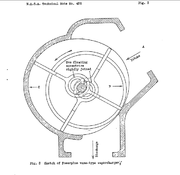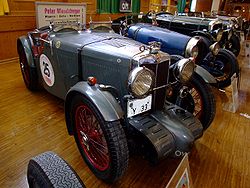
Powerplus supercharger
Encyclopedia

Supercharger
A supercharger is an air compressor used for forced induction of an internal combustion engine.The greater mass flow-rate provides more oxygen to support combustion than would be available in a naturally aspirated engine, which allows more fuel to be burned and more work to be done per cycle,...
used to boost the performance of car engines in the 1930s. It is a mechanically-driven positive displacement pump, operating on the sliding-vane principle.
MG cars

MG (car)
The MG Car Company is a former British sports car manufacturer founded in the 1920s by Cecil Kimber. Best known for its two-seat open sports cars, MG also produced saloons and coupés....
cars of the 1930s. MG specialised in small, lightweight "Midget" cars. Use of supercharging allowed engines of under 750 cc, 850 cc or 1,100 cc to generate competitive amounts of power, whilst still remaining in these small-engine classes.
The Powerplus design was the invention of Captain George Eyston
George Eyston
- References :*...
, the land speed record
Land speed record
The land speed record is the highest speed achieved by a wheeled vehicle on land. There is no single body for validation and regulation; in practice the Category C flying start regulations are used, officiated by regional or national organizations under the auspices of the Fédération...
holder. Supercharging first appeared on production MGs with the C type
MG C-Type
The MG C-type was produced by the MG Car company from 1931 to 1932. It was designed for competition use and based on the M-Type Midget. A special car, EX120 had been developed from the M-Type for George Eyston to make an attempt on the 750 cc class 24 hour record at Autodrome de Montlhéry in France...
or Montlhéry
Autodrome de Montlhéry
Autodrome de Montlhéry is an automobile racetrack, officially called L’autodrome de Linas-Montlhéry, located across the towns of Linas Bruyères-le-Châtel and Ollainville, outside Paris in the southside....
Midget, inspired by Eyston's EX120 record-breaker of 1930 – the first 750 cc car to break 100 mph.
In the 850 cc class, the 846 cc J3 and the rare (only nine were built) pure-racing J4 of 1932 used the Powerplus. All of MG's superchargers were mounted ahead of and roughly in-line with the crankshaft
Crankshaft
The crankshaft, sometimes casually abbreviated to crank, is the part of an engine which translates reciprocating linear piston motion into rotation...
, between the chassis dumb irons. The valance here was given a central bulge, capped with MG's octagon badge. The carburettor was a single large SU, mounted upstream of the blower for suck-through operation.
Perhaps the most famous of all supercharged MGs was the 1,087 cc K3 Magnette. Eyston was also a noted racer of MGs, particularly his K3 Magnette in the 1933 Isle of Man
Isle of Man
The Isle of Man , otherwise known simply as Mann , is a self-governing British Crown Dependency, located in the Irish Sea between the islands of Great Britain and Ireland, within the British Isles. The head of state is Queen Elizabeth II, who holds the title of Lord of Mann. The Lord of Mann is...
and 1934 Northern Ireland Tourist Trophy
RAC Tourist Trophy
The International Tourist Trophy is an award given by the Royal Automobile Club and awarded semi-annually to the winners of a selected motor racing event each year in the United Kingdom. It was first awarded in 1905 and continues to be awarded to this day, making it the longest lasting trophy in...
races and the Mille Miglia
Mille Miglia
The Mille Miglia was an open-road endurance race which took place in Italy twenty-four times from 1927 to 1957 ....
(both reprinted in ) Although these were not intended as everyday road cars, MG set out to produce competitive 'clubman's' racing cars at an affordable production-line price. In 1934 a K3 Magnette with racing bodywork and a pre-selector gearbox cost £795, around twice the price of the Magnette saloons.
Patents
Improvements in and connected with rotary pump machines- Applied for July 18, 1929
Eyston also held many other patents related to similar pumps.
Comparison to sliding vane
The innovation of the Powerplus was to take the sliding-vane design and to address its main drawbacks. Although the simple sliding-vane design is straightforward to manufacture, having simply shaped component parts, the spring-loaded vanes rub on the housing and this friction requires lubrication. In the 1920s, it was common for supercharged cars to have large consumable oil tanks mounted alongside the supercharger. Their HC exhaust emissions are not recorded.By adding a set of eccentrics and guide slots to the axle of the supercharger, the Powerplus actively controls the position of these vanes, such that they maintain a constant small clearance from the walls of the housing. This is enough spacing to avoid friction, but close enough to keep pumping efficient.
Comparison to Roots
The obvious advantage of the Powerplus over the RootsRoots type supercharger
The Roots type supercharger or Roots blower is a positive displacement lobe pump which operates by pumping fluids with a pair of meshing lobes not unlike a set of stretched gears. Fluid is trapped in pockets surrounding the lobes and carried from the intake side to the exhaust...
was avoidance of the need to machine the complex-shaped rotors. With the manufacturing technology of 1930, this was a serious consideration. Eyston himself already held patents related to these manufacturing difficulties.
The problem with Powerplus was firstly its complexity. Although each component was of simple form, there was some number of them, including a separate Bosch oil pump. This reduced reliability, compared to the simplicity of a Roots (once manufactured).
Secondly, studies by NACA
NACA
- Organizations :* National Advisory Committee for Aeronautics, the forerunner of the U.S. federal agency NASA* National Association for Campus Activities, an organization for programmers of university and college activities...
revealed that the Powerplus was less efficient than the Roots, i.e., more power was required to drive it. This was most pronounced at low-pressure differences. Where out-and-out performance was crucial, the Powerplus was competitive. However it was not likely to be preferred where efficiency or reduced fuel consumption were the deciding factors.

